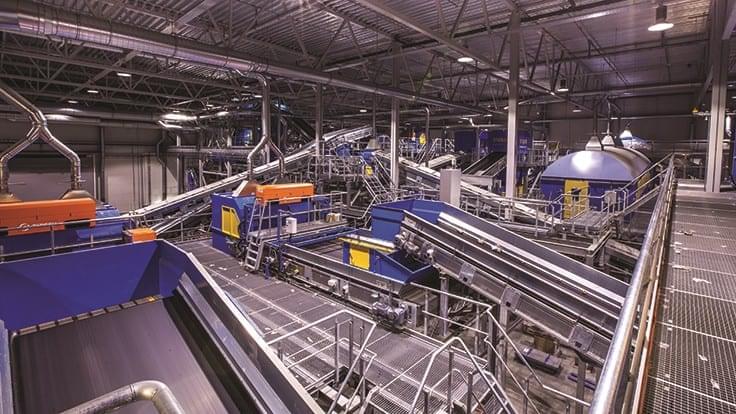New AI technology will make the world’s largest fleet of industrial mobile robots smarter and more efficient.



When fully automated waste and recycling facilities were just a concept in the industry, Norwegian municipal solid waste (MSW) hauling company Romerike Avfallsforedling (RoAF) turned the concept into a reality.
Powered by a sorting system installed by Germany-based Stadler Anlagenbau GmbH, RoAF opened the world’s first fully automated mixed waste processing facility in 2016 in the village of Skedsmokorset, just outside of Oslo, to help meet the needs of Norwegian municipalities that were facing high labor costs. While the concept was three years in the making, Stadler needed just three months to complete construction of the facility.
RoAF collects household and food waste from 10 municipalities in Norway, including Skedsmo, which boasts a population of roughly 53,000 people. When waste arrives at the automated plant, it’s first fed onto a conveyor, which delivers the waste into the sorting plant.

Fully automated autonomous city face_with_colon_three
Final Thoughts
The photos above are intended to open your mind to the possibilities of living in a 24-hour city.
There are many side effects to automation and not all of them are positive. But one aspect of our automated future will be 24-hour access to most goods and services, many of which are only available during normal business hours today.

KANSAS CITY, Mo. (KCTV) — Part of rolling out trash carts to Kansas City homes included a fully automated trash truck.
The City of Kansas City tweeted out a video of the truck hitting the road on it’s first day.

Live from CES in Las Vegas, NVIDIA CEO Jensen Huang shares how the next generation of accelerated computing and AI will transform every industry. The event kicks off with a one-hour NVIDIA pregame show where panelists discuss the future of AI infrastructure, open ecosystems, and physical AI.


The TOI Tech Desk is a dedicated team of journalists committed to delivering the latest and most relevant news from the world of technology to readers of The Times of India. TOI Tech Desk’s news coverage spans a wide spectrum across gadget launches, gadget reviews, trends, in-depth analysis, exclusive reports and breaking stories that impact technology and the digital universe. Be it how-tos or the latest happenings in AI, cybersecurity, personal gadgets, platforms like WhatsApp, Instagram, Facebook and more; TOI Tech Desk brings the news with accuracy and authenticity.
The deepest dive into philosopher Daniel Dennett’s mind.
TIMESTAMPS:
00:00 — The Soul.
03:18 — Most Important Philosophical Question.
12:06 — Do Qualia Exist?
30:28 — Uploading Consciousness.
39:55 — Thinking Differently.
56:20 — Pragmatism.
1:01:06 — Robert Sapolsky.
1:12:57 — Philosophers and Scientists.
1:29:30 — Patterns and Emergence.
1:36:46 — Roger Penrose.
1:42:39 — Sailing Boats.
1:45:40 — Fictionalism.
1:51:12 — Coming Up With Concepts.
1:59:55 — Douglas Hofstadter.
2:05:30 — AI Alignment Problem.
2:11:31 — Q&A
NOTE: The perspectives expressed by guests don’t necessarily mirror my own. There’s a versicolored arrangement of people on TOE, each harboring distinct viewpoints, as part of my endeavor to understand the perspectives that exist.
THANK YOU: To Mike Duffey for your insight, help, and recommendations on this channel.
Support TOE:
- Patreon: https://patreon.com/curtjaimungal (early access to ad-free audio episodes!)
- Crypto: https://tinyurl.com/cryptoTOE
- PayPal: https://tinyurl.com/paypalTOE
- TOE Merch: https://tinyurl.com/TOEmerch.
Follow TOE: